Global Business Environment: Analysis of Trade, Strategy & Challenges
VerifiedAdded on 2023/06/05
|13
|4654
|186
Report
AI Summary
This report provides a comprehensive analysis of the global business environment, focusing on the key factors that drive global trade and commerce, such as cost, market dynamics, environmental considerations, and competition. It evaluates the challenges and complexities faced by organizations like SASOL Ltd when operating in the global arena, including political, economic, social, technological, legal, and environmental factors. The report further examines the strategic challenges and risks associated with managing the supply chain flow and critically assesses the impact of globalisation on organizational governance, leadership, structure, culture, and functions. It also explores the influence of ethical and sustainable globalisation on organizational functions and evaluates different approaches to effective decision-making in a global context, highlighting various routes to internationalization and the key barriers encountered. The analysis includes a critical evaluation of the complexities and opportunities presented by the global business environment, with recommendations for adapting organizational structures and decision-making processes to navigate the challenges and capitalize on the opportunities.
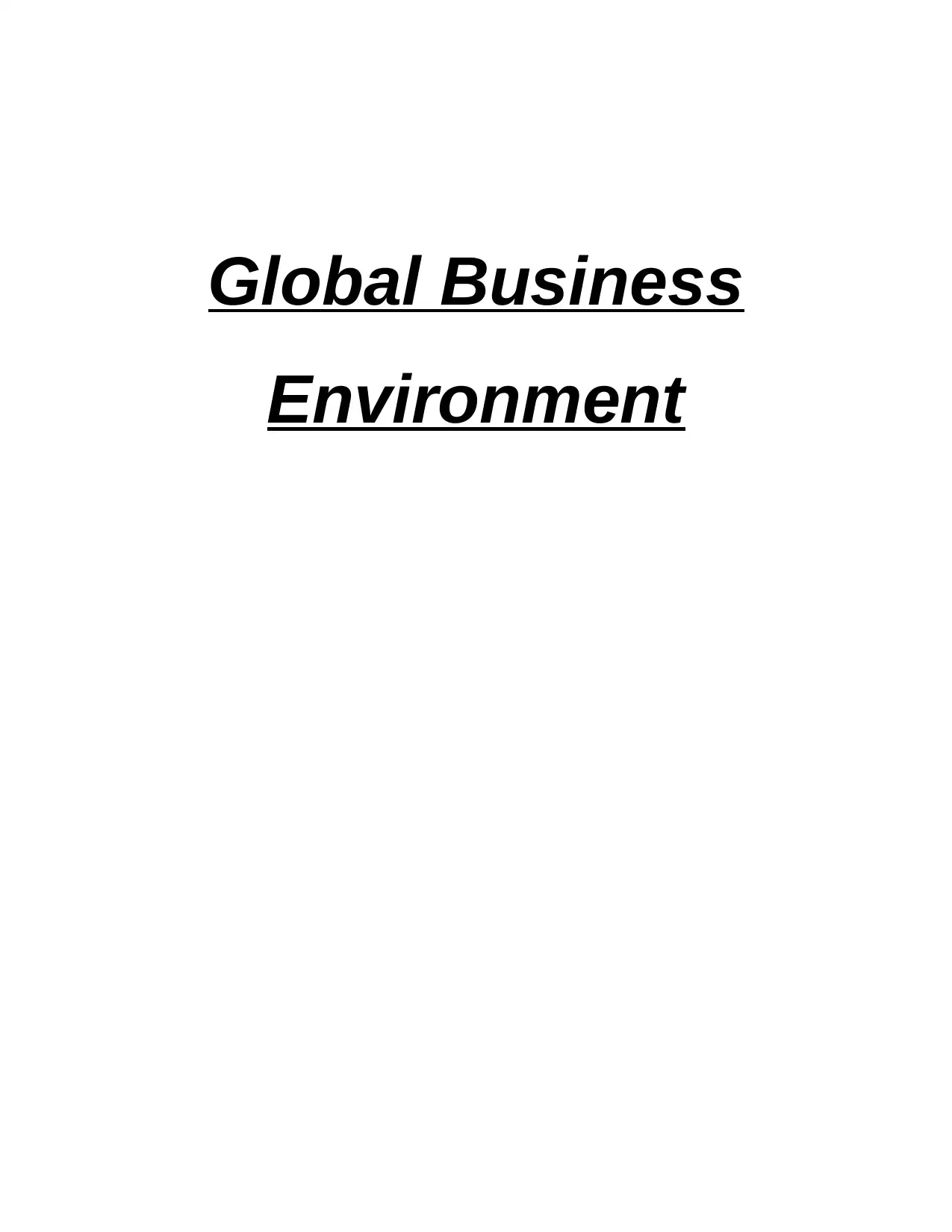
Global Business
Environment
Environment
Paraphrase This Document
Need a fresh take? Get an instant paraphrase of this document with our AI Paraphraser
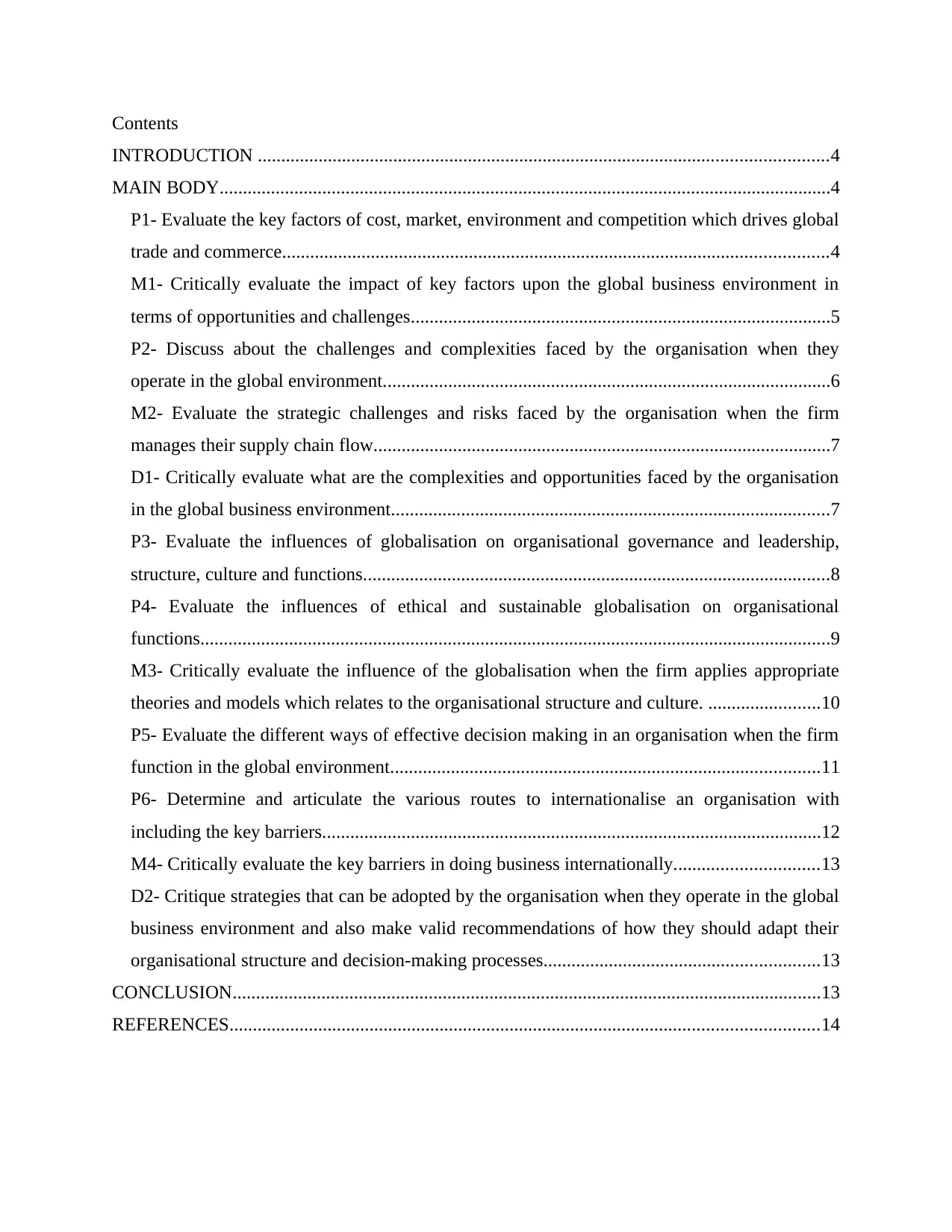
Contents
INTRODUCTION ..........................................................................................................................4
MAIN BODY...................................................................................................................................4
P1- Evaluate the key factors of cost, market, environment and competition which drives global
trade and commerce.....................................................................................................................4
M1- Critically evaluate the impact of key factors upon the global business environment in
terms of opportunities and challenges..........................................................................................5
P2- Discuss about the challenges and complexities faced by the organisation when they
operate in the global environment................................................................................................6
M2- Evaluate the strategic challenges and risks faced by the organisation when the firm
manages their supply chain flow..................................................................................................7
D1- Critically evaluate what are the complexities and opportunities faced by the organisation
in the global business environment..............................................................................................7
P3- Evaluate the influences of globalisation on organisational governance and leadership,
structure, culture and functions....................................................................................................8
P4- Evaluate the influences of ethical and sustainable globalisation on organisational
functions.......................................................................................................................................9
M3- Critically evaluate the influence of the globalisation when the firm applies appropriate
theories and models which relates to the organisational structure and culture. ........................10
P5- Evaluate the different ways of effective decision making in an organisation when the firm
function in the global environment............................................................................................11
P6- Determine and articulate the various routes to internationalise an organisation with
including the key barriers...........................................................................................................12
M4- Critically evaluate the key barriers in doing business internationally...............................13
D2- Critique strategies that can be adopted by the organisation when they operate in the global
business environment and also make valid recommendations of how they should adapt their
organisational structure and decision-making processes...........................................................13
CONCLUSION..............................................................................................................................13
REFERENCES..............................................................................................................................14
INTRODUCTION ..........................................................................................................................4
MAIN BODY...................................................................................................................................4
P1- Evaluate the key factors of cost, market, environment and competition which drives global
trade and commerce.....................................................................................................................4
M1- Critically evaluate the impact of key factors upon the global business environment in
terms of opportunities and challenges..........................................................................................5
P2- Discuss about the challenges and complexities faced by the organisation when they
operate in the global environment................................................................................................6
M2- Evaluate the strategic challenges and risks faced by the organisation when the firm
manages their supply chain flow..................................................................................................7
D1- Critically evaluate what are the complexities and opportunities faced by the organisation
in the global business environment..............................................................................................7
P3- Evaluate the influences of globalisation on organisational governance and leadership,
structure, culture and functions....................................................................................................8
P4- Evaluate the influences of ethical and sustainable globalisation on organisational
functions.......................................................................................................................................9
M3- Critically evaluate the influence of the globalisation when the firm applies appropriate
theories and models which relates to the organisational structure and culture. ........................10
P5- Evaluate the different ways of effective decision making in an organisation when the firm
function in the global environment............................................................................................11
P6- Determine and articulate the various routes to internationalise an organisation with
including the key barriers...........................................................................................................12
M4- Critically evaluate the key barriers in doing business internationally...............................13
D2- Critique strategies that can be adopted by the organisation when they operate in the global
business environment and also make valid recommendations of how they should adapt their
organisational structure and decision-making processes...........................................................13
CONCLUSION..............................................................................................................................13
REFERENCES..............................................................................................................................14
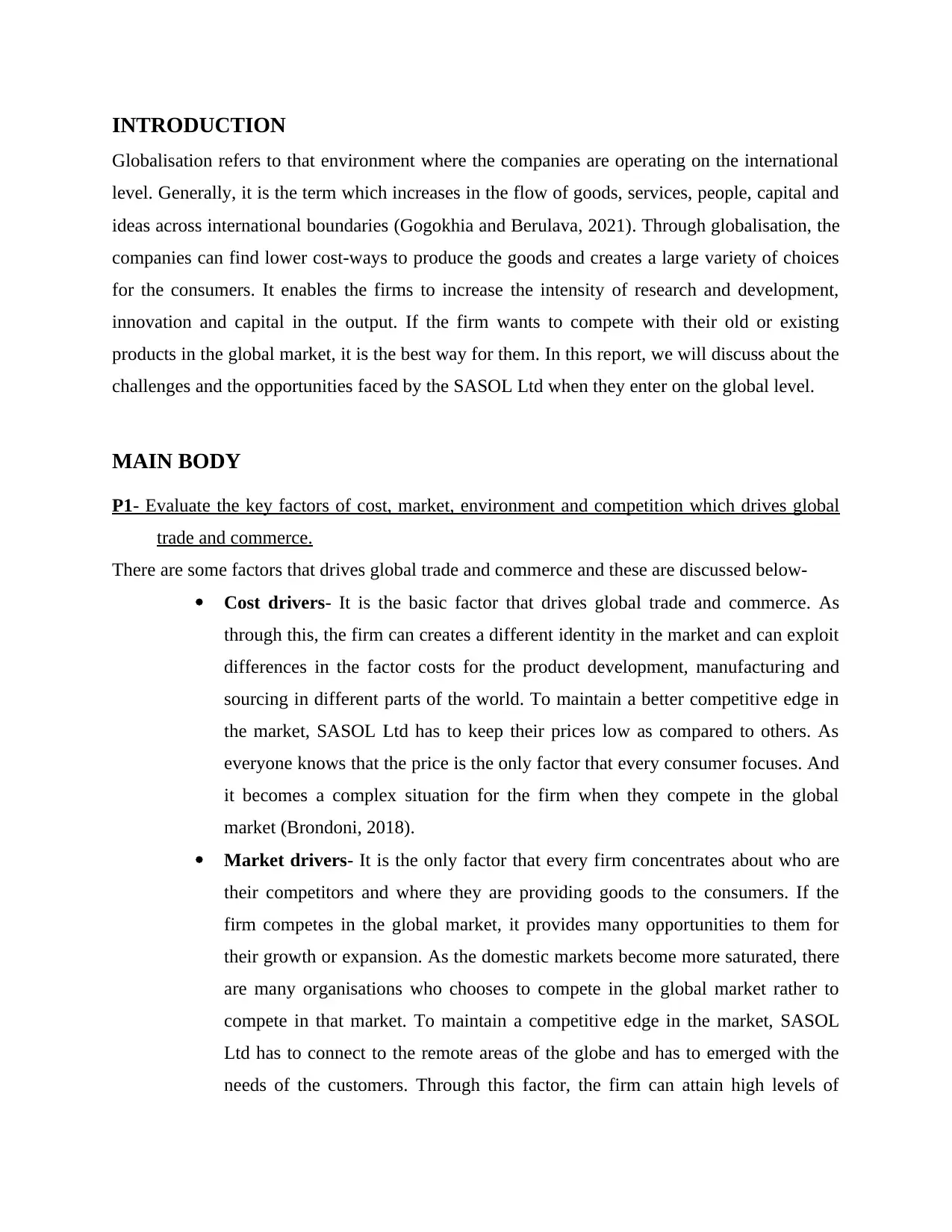
INTRODUCTION
Globalisation refers to that environment where the companies are operating on the international
level. Generally, it is the term which increases in the flow of goods, services, people, capital and
ideas across international boundaries (Gogokhia and Berulava, 2021). Through globalisation, the
companies can find lower cost-ways to produce the goods and creates a large variety of choices
for the consumers. It enables the firms to increase the intensity of research and development,
innovation and capital in the output. If the firm wants to compete with their old or existing
products in the global market, it is the best way for them. In this report, we will discuss about the
challenges and the opportunities faced by the SASOL Ltd when they enter on the global level.
MAIN BODY
P1- Evaluate the key factors of cost, market, environment and competition which drives global
trade and commerce.
There are some factors that drives global trade and commerce and these are discussed below-
Cost drivers- It is the basic factor that drives global trade and commerce. As
through this, the firm can creates a different identity in the market and can exploit
differences in the factor costs for the product development, manufacturing and
sourcing in different parts of the world. To maintain a better competitive edge in
the market, SASOL Ltd has to keep their prices low as compared to others. As
everyone knows that the price is the only factor that every consumer focuses. And
it becomes a complex situation for the firm when they compete in the global
market (Brondoni, 2018).
Market drivers- It is the only factor that every firm concentrates about who are
their competitors and where they are providing goods to the consumers. If the
firm competes in the global market, it provides many opportunities to them for
their growth or expansion. As the domestic markets become more saturated, there
are many organisations who chooses to compete in the global market rather to
compete in that market. To maintain a competitive edge in the market, SASOL
Ltd has to connect to the remote areas of the globe and has to emerged with the
needs of the customers. Through this factor, the firm can attain high levels of
Globalisation refers to that environment where the companies are operating on the international
level. Generally, it is the term which increases in the flow of goods, services, people, capital and
ideas across international boundaries (Gogokhia and Berulava, 2021). Through globalisation, the
companies can find lower cost-ways to produce the goods and creates a large variety of choices
for the consumers. It enables the firms to increase the intensity of research and development,
innovation and capital in the output. If the firm wants to compete with their old or existing
products in the global market, it is the best way for them. In this report, we will discuss about the
challenges and the opportunities faced by the SASOL Ltd when they enter on the global level.
MAIN BODY
P1- Evaluate the key factors of cost, market, environment and competition which drives global
trade and commerce.
There are some factors that drives global trade and commerce and these are discussed below-
Cost drivers- It is the basic factor that drives global trade and commerce. As
through this, the firm can creates a different identity in the market and can exploit
differences in the factor costs for the product development, manufacturing and
sourcing in different parts of the world. To maintain a better competitive edge in
the market, SASOL Ltd has to keep their prices low as compared to others. As
everyone knows that the price is the only factor that every consumer focuses. And
it becomes a complex situation for the firm when they compete in the global
market (Brondoni, 2018).
Market drivers- It is the only factor that every firm concentrates about who are
their competitors and where they are providing goods to the consumers. If the
firm competes in the global market, it provides many opportunities to them for
their growth or expansion. As the domestic markets become more saturated, there
are many organisations who chooses to compete in the global market rather to
compete in that market. To maintain a competitive edge in the market, SASOL
Ltd has to connect to the remote areas of the globe and has to emerged with the
needs of the customers. Through this factor, the firm can attain high levels of
⊘ This is a preview!⊘
Do you want full access?
Subscribe today to unlock all pages.

Trusted by 1+ million students worldwide

trade, competitive diversity and an interdependence which increases their
potential for the industry globalisation.
Environment drivers- The environment factor leads to increase the global
uniformity and creates a regular interconnection with them. This environment
factor provides a positive as well as negative impact to the global trade and
commerce. As through this factor, SASOL Ltd can produce a chemical reaction
which is generally occur in water or atmosphere and it may be less harmful than
other chemical reactions. As the firm takes use of soil and living organisms also
which helps them to utilize the hydrolysis and conjugation to degrade the
chemicals. The environment factor can disrupt trade as when the climate changes,
it directly influence the supply, transport and distribution chains infrastructure of
the firm. Overall, it may decrease the productivity of all the production factors
and result in output losses and a decrease in the volume of global trade of them.
Competitive drivers- Competition can improve the productivity and international
competitiveness of the business. Through the competition, the firm can able to
maintain their edge in the global market and also provide benefit to the customers.
If SASOL Ltd has to compete in the market for their customers, they has to lower
their prices, higher the quality of goods and services, greater the variety and
requires to do more innovation in their chemical products. Through this driver, the
firm can raise their goodwill across different nations (Martínez-Mora and Merino,
2020).
M1- Critically evaluate the impact of key factors upon the global business environment in terms
of opportunities and challenges.
The key factors of cost, market, environment and competition drives global trade and commerce
but the key factor of environment influences the global trade as well. Through the cost drivers,
the firm can creates a different identity and can easily compete in the market. And with the
market drivers, the company can attain high levels of trade and a competitive diversity among
the competitors. If SASOL Ltd produces their chemical product with the use of soil and living
organisms, it creates a less harmful product than others. And the firm has to be careful about the
climate changes when they produce their product.
potential for the industry globalisation.
Environment drivers- The environment factor leads to increase the global
uniformity and creates a regular interconnection with them. This environment
factor provides a positive as well as negative impact to the global trade and
commerce. As through this factor, SASOL Ltd can produce a chemical reaction
which is generally occur in water or atmosphere and it may be less harmful than
other chemical reactions. As the firm takes use of soil and living organisms also
which helps them to utilize the hydrolysis and conjugation to degrade the
chemicals. The environment factor can disrupt trade as when the climate changes,
it directly influence the supply, transport and distribution chains infrastructure of
the firm. Overall, it may decrease the productivity of all the production factors
and result in output losses and a decrease in the volume of global trade of them.
Competitive drivers- Competition can improve the productivity and international
competitiveness of the business. Through the competition, the firm can able to
maintain their edge in the global market and also provide benefit to the customers.
If SASOL Ltd has to compete in the market for their customers, they has to lower
their prices, higher the quality of goods and services, greater the variety and
requires to do more innovation in their chemical products. Through this driver, the
firm can raise their goodwill across different nations (Martínez-Mora and Merino,
2020).
M1- Critically evaluate the impact of key factors upon the global business environment in terms
of opportunities and challenges.
The key factors of cost, market, environment and competition drives global trade and commerce
but the key factor of environment influences the global trade as well. Through the cost drivers,
the firm can creates a different identity and can easily compete in the market. And with the
market drivers, the company can attain high levels of trade and a competitive diversity among
the competitors. If SASOL Ltd produces their chemical product with the use of soil and living
organisms, it creates a less harmful product than others. And the firm has to be careful about the
climate changes when they produce their product.
Paraphrase This Document
Need a fresh take? Get an instant paraphrase of this document with our AI Paraphraser
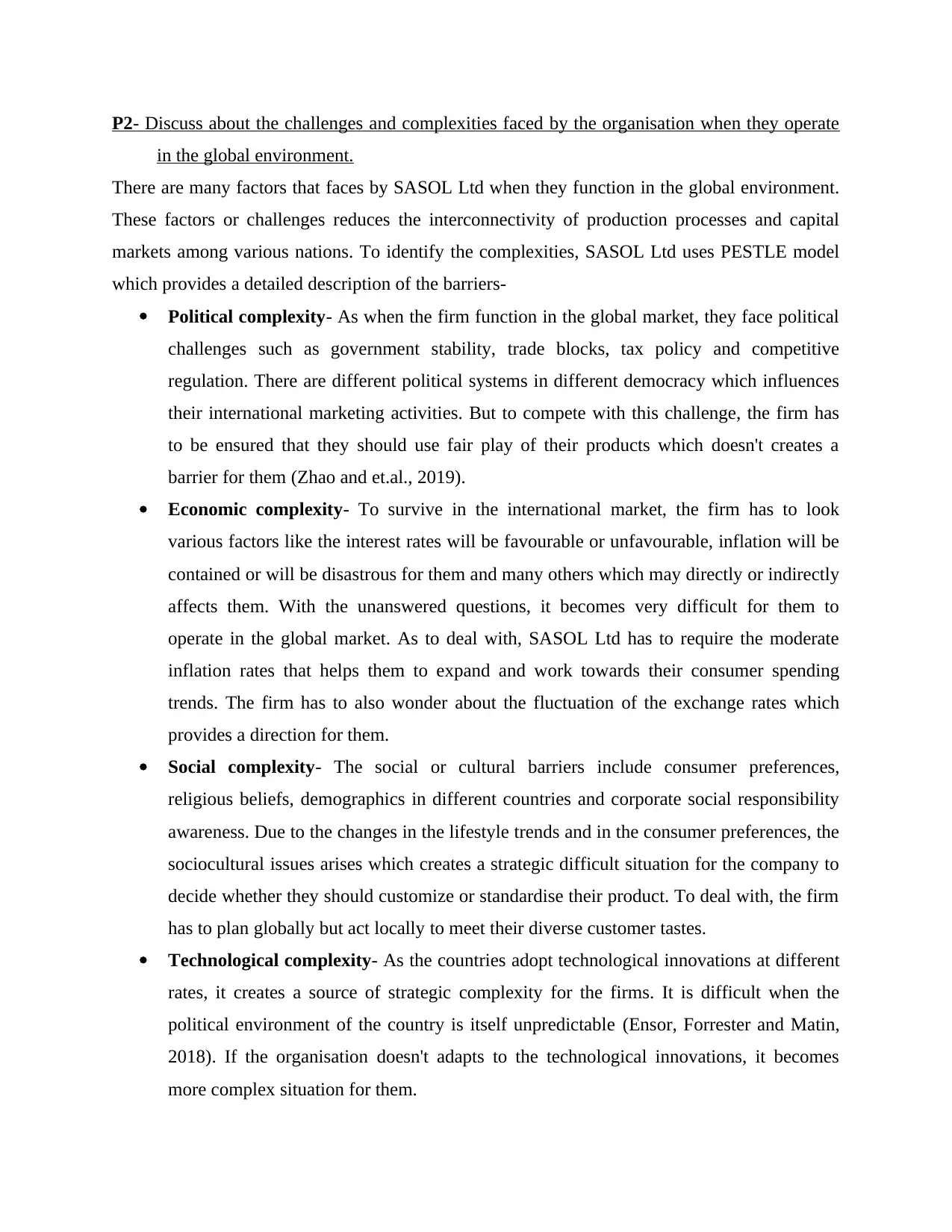
P2- Discuss about the challenges and complexities faced by the organisation when they operate
in the global environment.
There are many factors that faces by SASOL Ltd when they function in the global environment.
These factors or challenges reduces the interconnectivity of production processes and capital
markets among various nations. To identify the complexities, SASOL Ltd uses PESTLE model
which provides a detailed description of the barriers-
Political complexity- As when the firm function in the global market, they face political
challenges such as government stability, trade blocks, tax policy and competitive
regulation. There are different political systems in different democracy which influences
their international marketing activities. But to compete with this challenge, the firm has
to be ensured that they should use fair play of their products which doesn't creates a
barrier for them (Zhao and et.al., 2019).
Economic complexity- To survive in the international market, the firm has to look
various factors like the interest rates will be favourable or unfavourable, inflation will be
contained or will be disastrous for them and many others which may directly or indirectly
affects them. With the unanswered questions, it becomes very difficult for them to
operate in the global market. As to deal with, SASOL Ltd has to require the moderate
inflation rates that helps them to expand and work towards their consumer spending
trends. The firm has to also wonder about the fluctuation of the exchange rates which
provides a direction for them.
Social complexity- The social or cultural barriers include consumer preferences,
religious beliefs, demographics in different countries and corporate social responsibility
awareness. Due to the changes in the lifestyle trends and in the consumer preferences, the
sociocultural issues arises which creates a strategic difficult situation for the company to
decide whether they should customize or standardise their product. To deal with, the firm
has to plan globally but act locally to meet their diverse customer tastes.
Technological complexity- As the countries adopt technological innovations at different
rates, it creates a source of strategic complexity for the firms. It is difficult when the
political environment of the country is itself unpredictable (Ensor, Forrester and Matin,
2018). If the organisation doesn't adapts to the technological innovations, it becomes
more complex situation for them.
in the global environment.
There are many factors that faces by SASOL Ltd when they function in the global environment.
These factors or challenges reduces the interconnectivity of production processes and capital
markets among various nations. To identify the complexities, SASOL Ltd uses PESTLE model
which provides a detailed description of the barriers-
Political complexity- As when the firm function in the global market, they face political
challenges such as government stability, trade blocks, tax policy and competitive
regulation. There are different political systems in different democracy which influences
their international marketing activities. But to compete with this challenge, the firm has
to be ensured that they should use fair play of their products which doesn't creates a
barrier for them (Zhao and et.al., 2019).
Economic complexity- To survive in the international market, the firm has to look
various factors like the interest rates will be favourable or unfavourable, inflation will be
contained or will be disastrous for them and many others which may directly or indirectly
affects them. With the unanswered questions, it becomes very difficult for them to
operate in the global market. As to deal with, SASOL Ltd has to require the moderate
inflation rates that helps them to expand and work towards their consumer spending
trends. The firm has to also wonder about the fluctuation of the exchange rates which
provides a direction for them.
Social complexity- The social or cultural barriers include consumer preferences,
religious beliefs, demographics in different countries and corporate social responsibility
awareness. Due to the changes in the lifestyle trends and in the consumer preferences, the
sociocultural issues arises which creates a strategic difficult situation for the company to
decide whether they should customize or standardise their product. To deal with, the firm
has to plan globally but act locally to meet their diverse customer tastes.
Technological complexity- As the countries adopt technological innovations at different
rates, it creates a source of strategic complexity for the firms. It is difficult when the
political environment of the country is itself unpredictable (Ensor, Forrester and Matin,
2018). If the organisation doesn't adapts to the technological innovations, it becomes
more complex situation for them.
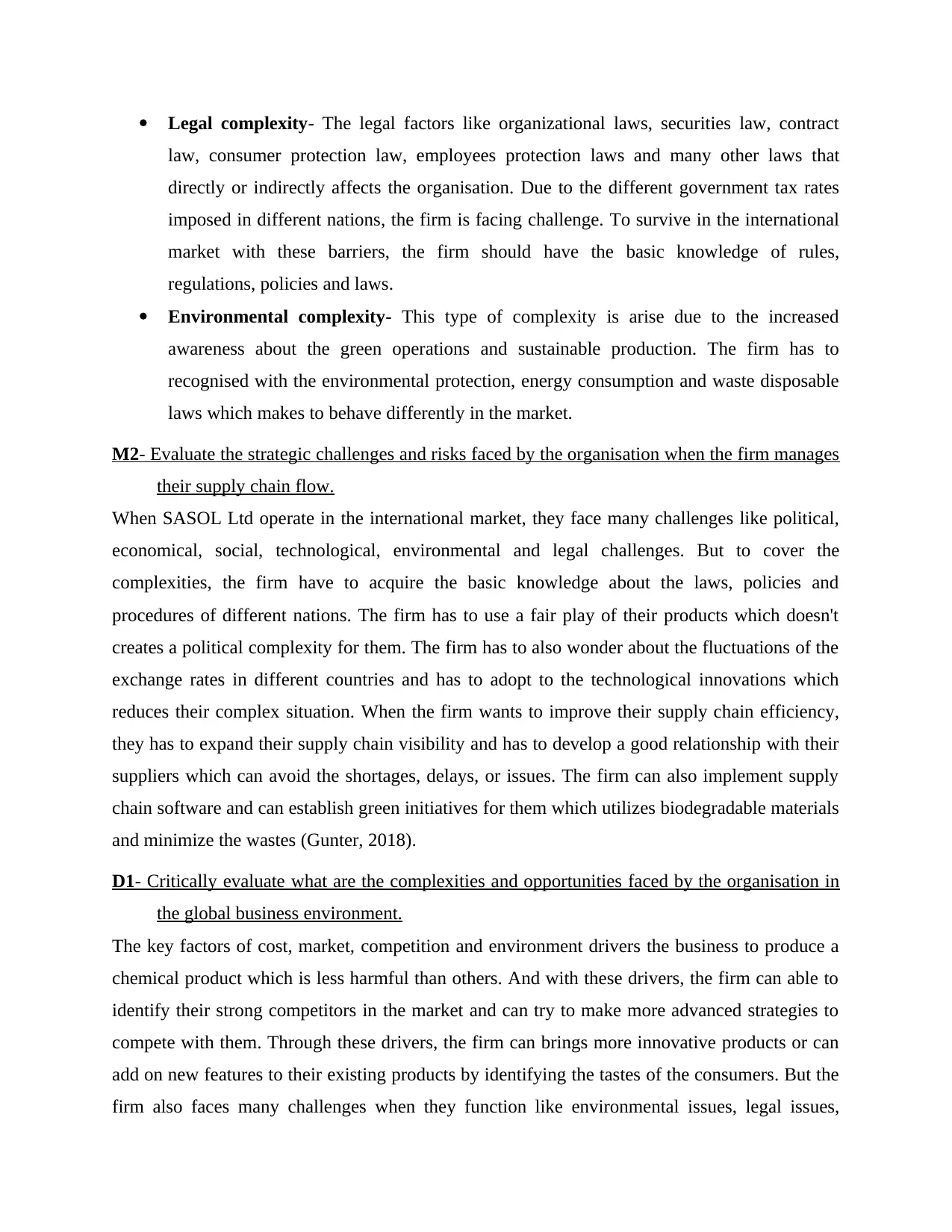
Legal complexity- The legal factors like organizational laws, securities law, contract
law, consumer protection law, employees protection laws and many other laws that
directly or indirectly affects the organisation. Due to the different government tax rates
imposed in different nations, the firm is facing challenge. To survive in the international
market with these barriers, the firm should have the basic knowledge of rules,
regulations, policies and laws.
Environmental complexity- This type of complexity is arise due to the increased
awareness about the green operations and sustainable production. The firm has to
recognised with the environmental protection, energy consumption and waste disposable
laws which makes to behave differently in the market.
M2- Evaluate the strategic challenges and risks faced by the organisation when the firm manages
their supply chain flow.
When SASOL Ltd operate in the international market, they face many challenges like political,
economical, social, technological, environmental and legal challenges. But to cover the
complexities, the firm have to acquire the basic knowledge about the laws, policies and
procedures of different nations. The firm has to use a fair play of their products which doesn't
creates a political complexity for them. The firm has to also wonder about the fluctuations of the
exchange rates in different countries and has to adopt to the technological innovations which
reduces their complex situation. When the firm wants to improve their supply chain efficiency,
they has to expand their supply chain visibility and has to develop a good relationship with their
suppliers which can avoid the shortages, delays, or issues. The firm can also implement supply
chain software and can establish green initiatives for them which utilizes biodegradable materials
and minimize the wastes (Gunter, 2018).
D1- Critically evaluate what are the complexities and opportunities faced by the organisation in
the global business environment.
The key factors of cost, market, competition and environment drivers the business to produce a
chemical product which is less harmful than others. And with these drivers, the firm can able to
identify their strong competitors in the market and can try to make more advanced strategies to
compete with them. Through these drivers, the firm can brings more innovative products or can
add on new features to their existing products by identifying the tastes of the consumers. But the
firm also faces many challenges when they function like environmental issues, legal issues,
law, consumer protection law, employees protection laws and many other laws that
directly or indirectly affects the organisation. Due to the different government tax rates
imposed in different nations, the firm is facing challenge. To survive in the international
market with these barriers, the firm should have the basic knowledge of rules,
regulations, policies and laws.
Environmental complexity- This type of complexity is arise due to the increased
awareness about the green operations and sustainable production. The firm has to
recognised with the environmental protection, energy consumption and waste disposable
laws which makes to behave differently in the market.
M2- Evaluate the strategic challenges and risks faced by the organisation when the firm manages
their supply chain flow.
When SASOL Ltd operate in the international market, they face many challenges like political,
economical, social, technological, environmental and legal challenges. But to cover the
complexities, the firm have to acquire the basic knowledge about the laws, policies and
procedures of different nations. The firm has to use a fair play of their products which doesn't
creates a political complexity for them. The firm has to also wonder about the fluctuations of the
exchange rates in different countries and has to adopt to the technological innovations which
reduces their complex situation. When the firm wants to improve their supply chain efficiency,
they has to expand their supply chain visibility and has to develop a good relationship with their
suppliers which can avoid the shortages, delays, or issues. The firm can also implement supply
chain software and can establish green initiatives for them which utilizes biodegradable materials
and minimize the wastes (Gunter, 2018).
D1- Critically evaluate what are the complexities and opportunities faced by the organisation in
the global business environment.
The key factors of cost, market, competition and environment drivers the business to produce a
chemical product which is less harmful than others. And with these drivers, the firm can able to
identify their strong competitors in the market and can try to make more advanced strategies to
compete with them. Through these drivers, the firm can brings more innovative products or can
add on new features to their existing products by identifying the tastes of the consumers. But the
firm also faces many challenges when they function like environmental issues, legal issues,
⊘ This is a preview!⊘
Do you want full access?
Subscribe today to unlock all pages.

Trusted by 1+ million students worldwide
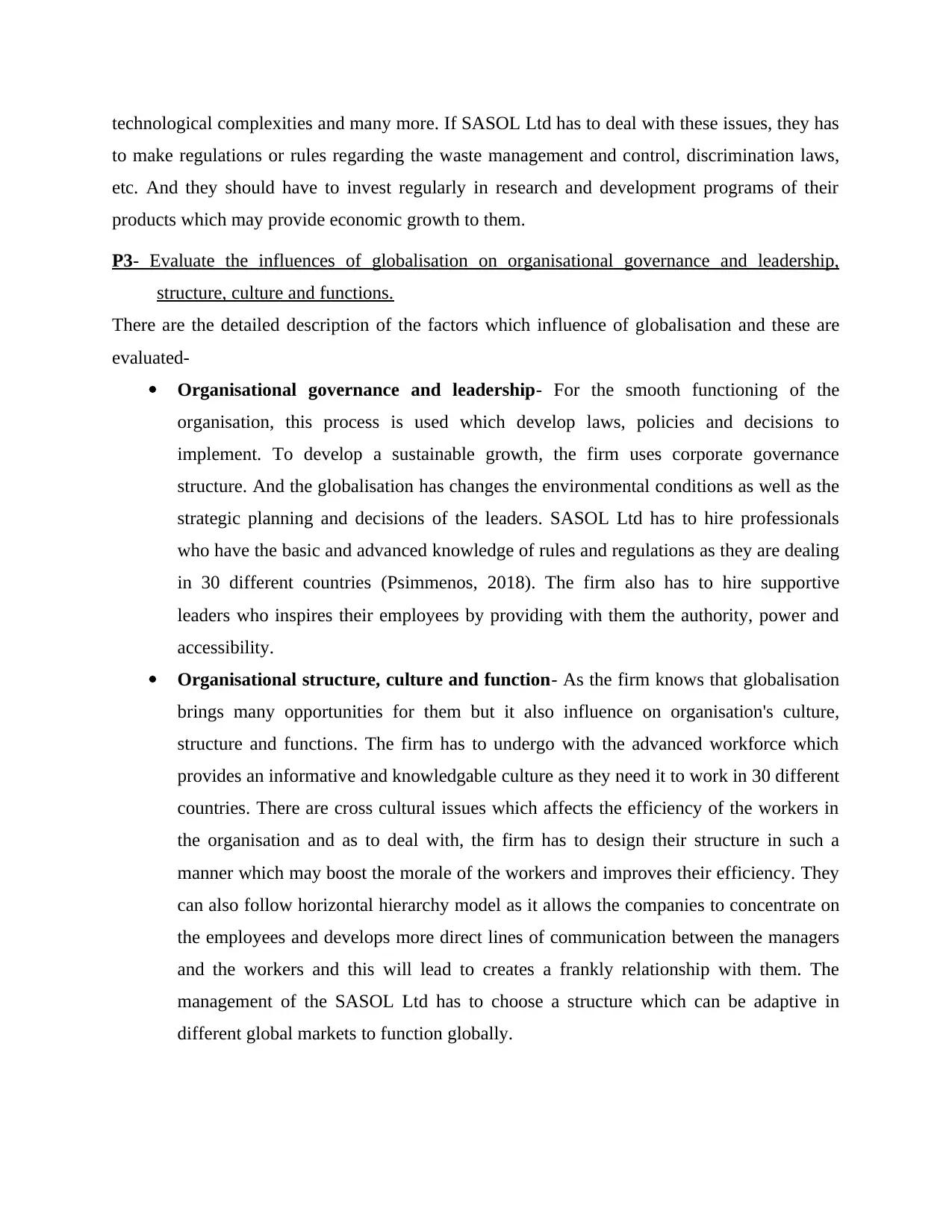
technological complexities and many more. If SASOL Ltd has to deal with these issues, they has
to make regulations or rules regarding the waste management and control, discrimination laws,
etc. And they should have to invest regularly in research and development programs of their
products which may provide economic growth to them.
P3- Evaluate the influences of globalisation on organisational governance and leadership,
structure, culture and functions.
There are the detailed description of the factors which influence of globalisation and these are
evaluated-
Organisational governance and leadership- For the smooth functioning of the
organisation, this process is used which develop laws, policies and decisions to
implement. To develop a sustainable growth, the firm uses corporate governance
structure. And the globalisation has changes the environmental conditions as well as the
strategic planning and decisions of the leaders. SASOL Ltd has to hire professionals
who have the basic and advanced knowledge of rules and regulations as they are dealing
in 30 different countries (Psimmenos, 2018). The firm also has to hire supportive
leaders who inspires their employees by providing with them the authority, power and
accessibility.
Organisational structure, culture and function- As the firm knows that globalisation
brings many opportunities for them but it also influence on organisation's culture,
structure and functions. The firm has to undergo with the advanced workforce which
provides an informative and knowledgable culture as they need it to work in 30 different
countries. There are cross cultural issues which affects the efficiency of the workers in
the organisation and as to deal with, the firm has to design their structure in such a
manner which may boost the morale of the workers and improves their efficiency. They
can also follow horizontal hierarchy model as it allows the companies to concentrate on
the employees and develops more direct lines of communication between the managers
and the workers and this will lead to creates a frankly relationship with them. The
management of the SASOL Ltd has to choose a structure which can be adaptive in
different global markets to function globally.
to make regulations or rules regarding the waste management and control, discrimination laws,
etc. And they should have to invest regularly in research and development programs of their
products which may provide economic growth to them.
P3- Evaluate the influences of globalisation on organisational governance and leadership,
structure, culture and functions.
There are the detailed description of the factors which influence of globalisation and these are
evaluated-
Organisational governance and leadership- For the smooth functioning of the
organisation, this process is used which develop laws, policies and decisions to
implement. To develop a sustainable growth, the firm uses corporate governance
structure. And the globalisation has changes the environmental conditions as well as the
strategic planning and decisions of the leaders. SASOL Ltd has to hire professionals
who have the basic and advanced knowledge of rules and regulations as they are dealing
in 30 different countries (Psimmenos, 2018). The firm also has to hire supportive
leaders who inspires their employees by providing with them the authority, power and
accessibility.
Organisational structure, culture and function- As the firm knows that globalisation
brings many opportunities for them but it also influence on organisation's culture,
structure and functions. The firm has to undergo with the advanced workforce which
provides an informative and knowledgable culture as they need it to work in 30 different
countries. There are cross cultural issues which affects the efficiency of the workers in
the organisation and as to deal with, the firm has to design their structure in such a
manner which may boost the morale of the workers and improves their efficiency. They
can also follow horizontal hierarchy model as it allows the companies to concentrate on
the employees and develops more direct lines of communication between the managers
and the workers and this will lead to creates a frankly relationship with them. The
management of the SASOL Ltd has to choose a structure which can be adaptive in
different global markets to function globally.
Paraphrase This Document
Need a fresh take? Get an instant paraphrase of this document with our AI Paraphraser
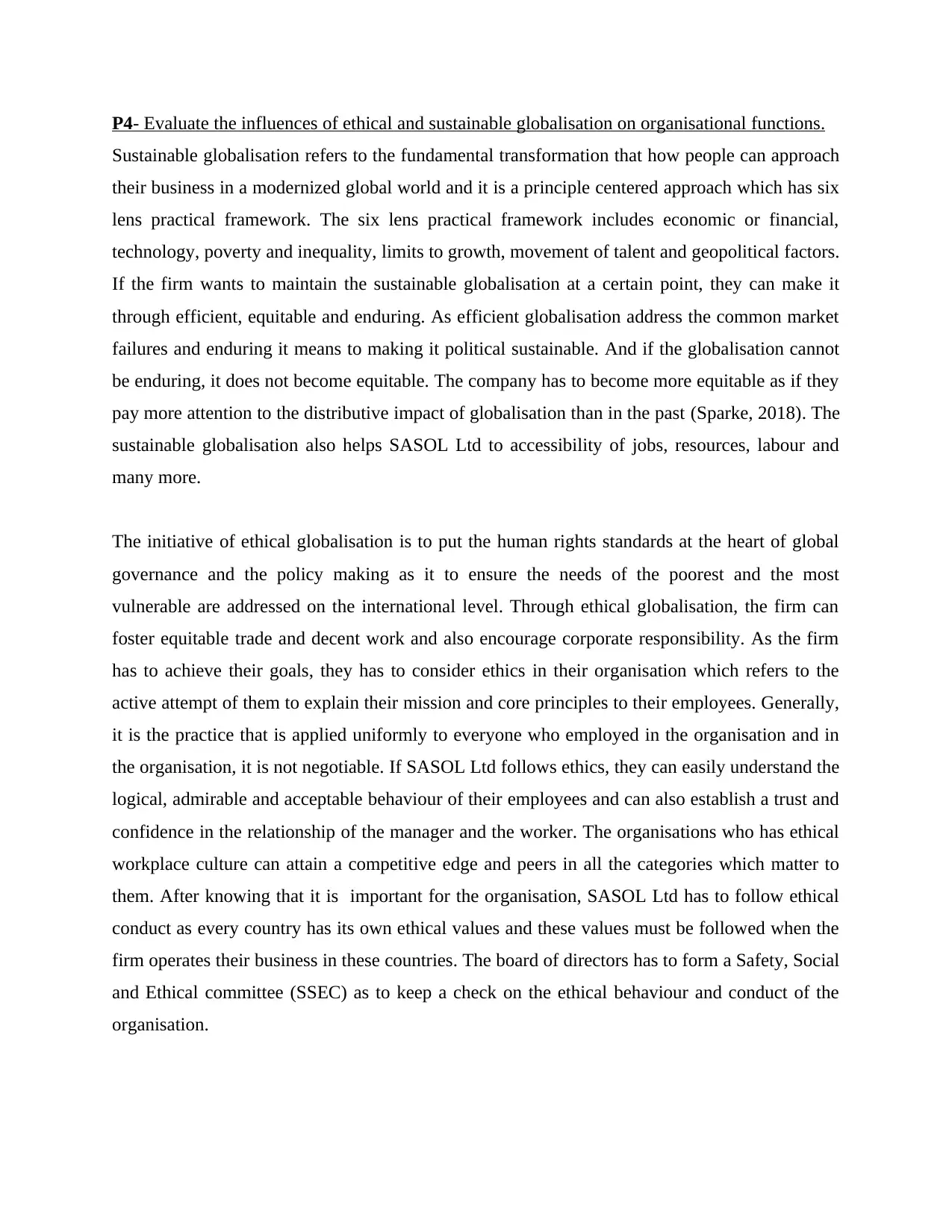
P4- Evaluate the influences of ethical and sustainable globalisation on organisational functions.
Sustainable globalisation refers to the fundamental transformation that how people can approach
their business in a modernized global world and it is a principle centered approach which has six
lens practical framework. The six lens practical framework includes economic or financial,
technology, poverty and inequality, limits to growth, movement of talent and geopolitical factors.
If the firm wants to maintain the sustainable globalisation at a certain point, they can make it
through efficient, equitable and enduring. As efficient globalisation address the common market
failures and enduring it means to making it political sustainable. And if the globalisation cannot
be enduring, it does not become equitable. The company has to become more equitable as if they
pay more attention to the distributive impact of globalisation than in the past (Sparke, 2018). The
sustainable globalisation also helps SASOL Ltd to accessibility of jobs, resources, labour and
many more.
The initiative of ethical globalisation is to put the human rights standards at the heart of global
governance and the policy making as it to ensure the needs of the poorest and the most
vulnerable are addressed on the international level. Through ethical globalisation, the firm can
foster equitable trade and decent work and also encourage corporate responsibility. As the firm
has to achieve their goals, they has to consider ethics in their organisation which refers to the
active attempt of them to explain their mission and core principles to their employees. Generally,
it is the practice that is applied uniformly to everyone who employed in the organisation and in
the organisation, it is not negotiable. If SASOL Ltd follows ethics, they can easily understand the
logical, admirable and acceptable behaviour of their employees and can also establish a trust and
confidence in the relationship of the manager and the worker. The organisations who has ethical
workplace culture can attain a competitive edge and peers in all the categories which matter to
them. After knowing that it is important for the organisation, SASOL Ltd has to follow ethical
conduct as every country has its own ethical values and these values must be followed when the
firm operates their business in these countries. The board of directors has to form a Safety, Social
and Ethical committee (SSEC) as to keep a check on the ethical behaviour and conduct of the
organisation.
Sustainable globalisation refers to the fundamental transformation that how people can approach
their business in a modernized global world and it is a principle centered approach which has six
lens practical framework. The six lens practical framework includes economic or financial,
technology, poverty and inequality, limits to growth, movement of talent and geopolitical factors.
If the firm wants to maintain the sustainable globalisation at a certain point, they can make it
through efficient, equitable and enduring. As efficient globalisation address the common market
failures and enduring it means to making it political sustainable. And if the globalisation cannot
be enduring, it does not become equitable. The company has to become more equitable as if they
pay more attention to the distributive impact of globalisation than in the past (Sparke, 2018). The
sustainable globalisation also helps SASOL Ltd to accessibility of jobs, resources, labour and
many more.
The initiative of ethical globalisation is to put the human rights standards at the heart of global
governance and the policy making as it to ensure the needs of the poorest and the most
vulnerable are addressed on the international level. Through ethical globalisation, the firm can
foster equitable trade and decent work and also encourage corporate responsibility. As the firm
has to achieve their goals, they has to consider ethics in their organisation which refers to the
active attempt of them to explain their mission and core principles to their employees. Generally,
it is the practice that is applied uniformly to everyone who employed in the organisation and in
the organisation, it is not negotiable. If SASOL Ltd follows ethics, they can easily understand the
logical, admirable and acceptable behaviour of their employees and can also establish a trust and
confidence in the relationship of the manager and the worker. The organisations who has ethical
workplace culture can attain a competitive edge and peers in all the categories which matter to
them. After knowing that it is important for the organisation, SASOL Ltd has to follow ethical
conduct as every country has its own ethical values and these values must be followed when the
firm operates their business in these countries. The board of directors has to form a Safety, Social
and Ethical committee (SSEC) as to keep a check on the ethical behaviour and conduct of the
organisation.
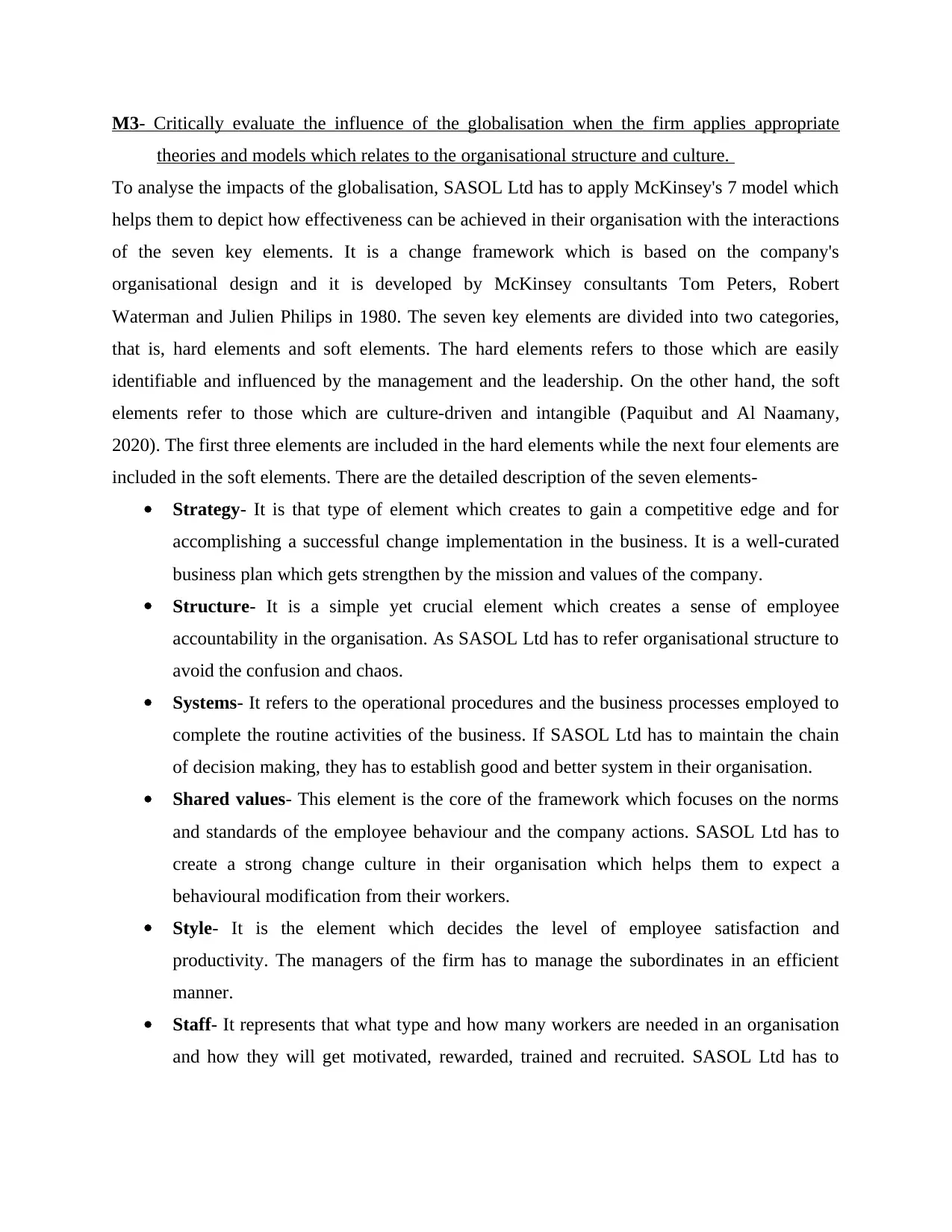
M3- Critically evaluate the influence of the globalisation when the firm applies appropriate
theories and models which relates to the organisational structure and culture.
To analyse the impacts of the globalisation, SASOL Ltd has to apply McKinsey's 7 model which
helps them to depict how effectiveness can be achieved in their organisation with the interactions
of the seven key elements. It is a change framework which is based on the company's
organisational design and it is developed by McKinsey consultants Tom Peters, Robert
Waterman and Julien Philips in 1980. The seven key elements are divided into two categories,
that is, hard elements and soft elements. The hard elements refers to those which are easily
identifiable and influenced by the management and the leadership. On the other hand, the soft
elements refer to those which are culture-driven and intangible (Paquibut and Al Naamany,
2020). The first three elements are included in the hard elements while the next four elements are
included in the soft elements. There are the detailed description of the seven elements-
Strategy- It is that type of element which creates to gain a competitive edge and for
accomplishing a successful change implementation in the business. It is a well-curated
business plan which gets strengthen by the mission and values of the company.
Structure- It is a simple yet crucial element which creates a sense of employee
accountability in the organisation. As SASOL Ltd has to refer organisational structure to
avoid the confusion and chaos.
Systems- It refers to the operational procedures and the business processes employed to
complete the routine activities of the business. If SASOL Ltd has to maintain the chain
of decision making, they has to establish good and better system in their organisation.
Shared values- This element is the core of the framework which focuses on the norms
and standards of the employee behaviour and the company actions. SASOL Ltd has to
create a strong change culture in their organisation which helps them to expect a
behavioural modification from their workers.
Style- It is the element which decides the level of employee satisfaction and
productivity. The managers of the firm has to manage the subordinates in an efficient
manner.
Staff- It represents that what type and how many workers are needed in an organisation
and how they will get motivated, rewarded, trained and recruited. SASOL Ltd has to
theories and models which relates to the organisational structure and culture.
To analyse the impacts of the globalisation, SASOL Ltd has to apply McKinsey's 7 model which
helps them to depict how effectiveness can be achieved in their organisation with the interactions
of the seven key elements. It is a change framework which is based on the company's
organisational design and it is developed by McKinsey consultants Tom Peters, Robert
Waterman and Julien Philips in 1980. The seven key elements are divided into two categories,
that is, hard elements and soft elements. The hard elements refers to those which are easily
identifiable and influenced by the management and the leadership. On the other hand, the soft
elements refer to those which are culture-driven and intangible (Paquibut and Al Naamany,
2020). The first three elements are included in the hard elements while the next four elements are
included in the soft elements. There are the detailed description of the seven elements-
Strategy- It is that type of element which creates to gain a competitive edge and for
accomplishing a successful change implementation in the business. It is a well-curated
business plan which gets strengthen by the mission and values of the company.
Structure- It is a simple yet crucial element which creates a sense of employee
accountability in the organisation. As SASOL Ltd has to refer organisational structure to
avoid the confusion and chaos.
Systems- It refers to the operational procedures and the business processes employed to
complete the routine activities of the business. If SASOL Ltd has to maintain the chain
of decision making, they has to establish good and better system in their organisation.
Shared values- This element is the core of the framework which focuses on the norms
and standards of the employee behaviour and the company actions. SASOL Ltd has to
create a strong change culture in their organisation which helps them to expect a
behavioural modification from their workers.
Style- It is the element which decides the level of employee satisfaction and
productivity. The managers of the firm has to manage the subordinates in an efficient
manner.
Staff- It represents that what type and how many workers are needed in an organisation
and how they will get motivated, rewarded, trained and recruited. SASOL Ltd has to
⊘ This is a preview!⊘
Do you want full access?
Subscribe today to unlock all pages.

Trusted by 1+ million students worldwide
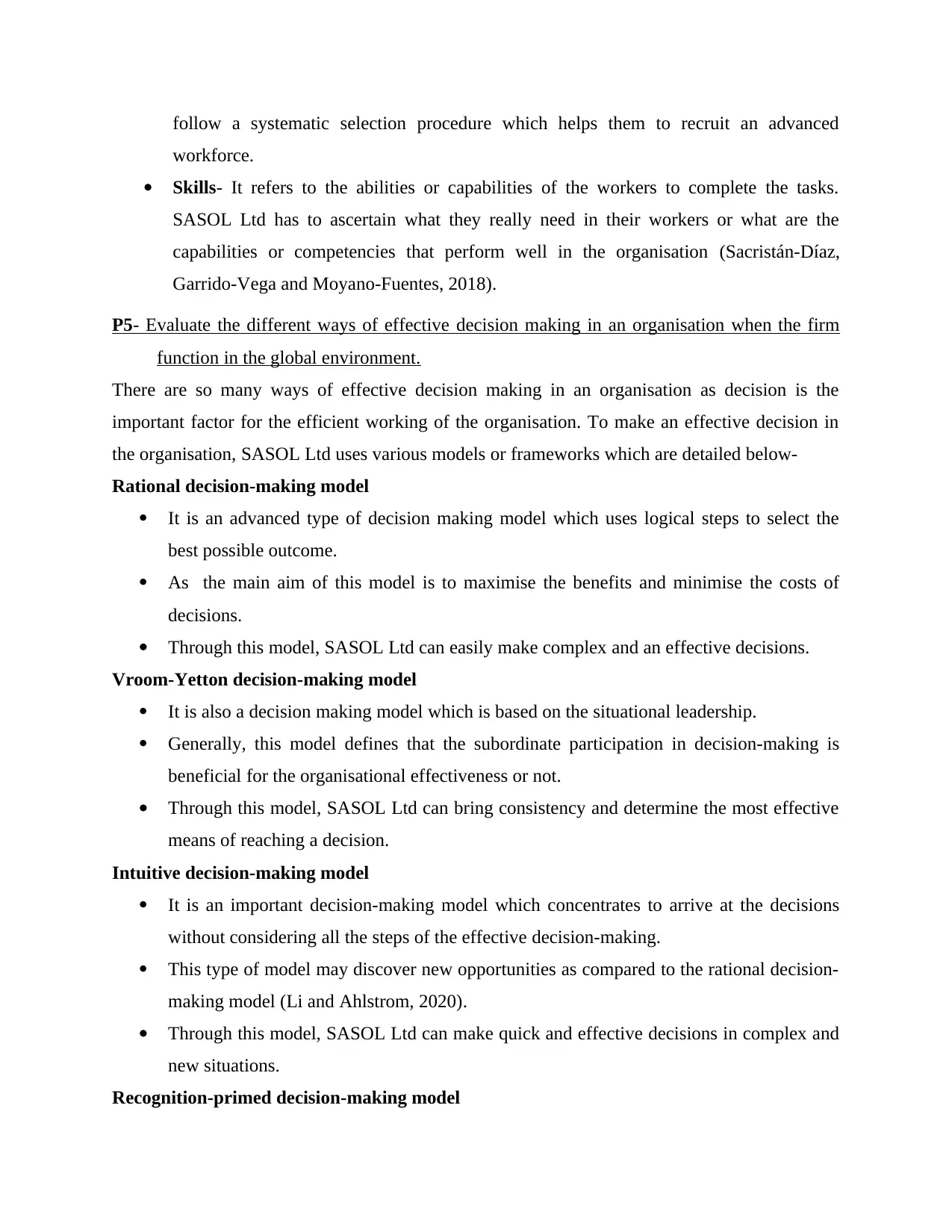
follow a systematic selection procedure which helps them to recruit an advanced
workforce.
Skills- It refers to the abilities or capabilities of the workers to complete the tasks.
SASOL Ltd has to ascertain what they really need in their workers or what are the
capabilities or competencies that perform well in the organisation (Sacristán-Díaz,
Garrido-Vega and Moyano-Fuentes, 2018).
P5- Evaluate the different ways of effective decision making in an organisation when the firm
function in the global environment.
There are so many ways of effective decision making in an organisation as decision is the
important factor for the efficient working of the organisation. To make an effective decision in
the organisation, SASOL Ltd uses various models or frameworks which are detailed below-
Rational decision-making model
It is an advanced type of decision making model which uses logical steps to select the
best possible outcome.
As the main aim of this model is to maximise the benefits and minimise the costs of
decisions.
Through this model, SASOL Ltd can easily make complex and an effective decisions.
Vroom-Yetton decision-making model
It is also a decision making model which is based on the situational leadership.
Generally, this model defines that the subordinate participation in decision-making is
beneficial for the organisational effectiveness or not.
Through this model, SASOL Ltd can bring consistency and determine the most effective
means of reaching a decision.
Intuitive decision-making model
It is an important decision-making model which concentrates to arrive at the decisions
without considering all the steps of the effective decision-making.
This type of model may discover new opportunities as compared to the rational decision-
making model (Li and Ahlstrom, 2020).
Through this model, SASOL Ltd can make quick and effective decisions in complex and
new situations.
Recognition-primed decision-making model
workforce.
Skills- It refers to the abilities or capabilities of the workers to complete the tasks.
SASOL Ltd has to ascertain what they really need in their workers or what are the
capabilities or competencies that perform well in the organisation (Sacristán-Díaz,
Garrido-Vega and Moyano-Fuentes, 2018).
P5- Evaluate the different ways of effective decision making in an organisation when the firm
function in the global environment.
There are so many ways of effective decision making in an organisation as decision is the
important factor for the efficient working of the organisation. To make an effective decision in
the organisation, SASOL Ltd uses various models or frameworks which are detailed below-
Rational decision-making model
It is an advanced type of decision making model which uses logical steps to select the
best possible outcome.
As the main aim of this model is to maximise the benefits and minimise the costs of
decisions.
Through this model, SASOL Ltd can easily make complex and an effective decisions.
Vroom-Yetton decision-making model
It is also a decision making model which is based on the situational leadership.
Generally, this model defines that the subordinate participation in decision-making is
beneficial for the organisational effectiveness or not.
Through this model, SASOL Ltd can bring consistency and determine the most effective
means of reaching a decision.
Intuitive decision-making model
It is an important decision-making model which concentrates to arrive at the decisions
without considering all the steps of the effective decision-making.
This type of model may discover new opportunities as compared to the rational decision-
making model (Li and Ahlstrom, 2020).
Through this model, SASOL Ltd can make quick and effective decisions in complex and
new situations.
Recognition-primed decision-making model
Paraphrase This Document
Need a fresh take? Get an instant paraphrase of this document with our AI Paraphraser

It is a model of decision-making which helps new professionals to quickly learn to make
important decisions in the complex situations.
The main aim of this model is to help experienced individuals to make the decisions,
tackle it and solve the problems.
When there is need of instant decisions and incomplete information is present in SASOL
Ltd, this method is mostly valuable for them.
P6- Determine and articulate the various routes to internationalise an organisation with including
the key barriers.
There are several routes to internationalise an organisation and if SASOL Ltd decides to enter
into global market, they has to follow various routes which are listed down below-
Exporting- It is the common route which is followed by many organisations as
producing in one country and shipping it to the another country. Through this way, the
firm can rapidly expand their potential market on the global level. SASOL Ltd supplies
coal to the export market for their expansion in the international environment as they are
the largest producer of coal in South Africa (Crosbie, 2019).
Franchising- It is a strategy for the business expansion and it a type of license where one
party allows another one to sell their products and intellectual property under their
business's name. SASOL Ltd can use franchising to expand their business as they
appoints Sasol Convenience Centres (SSCs) franchisee to manage and operate their
business operations in different countries.
Licensing- It refers to the permission from the licensor to manufacture and sell their
goods and services in a defined market area. The company who obtains this right has to
usually pay a royalty fee to the original owner. SASOL Ltd license their products and
services in various countries to consider growth at the international level.
Joint venture- It refers to the clubbing of two or more than two parties which seeks to
develop a single enterprise for the same goal or objective with sharing the risks. Through
this, the company can access to new markets, distribution networks, greater resources and
many more (Nielsen, Marinova and Marinova, 2022). The parties in the joint venture are
liable for the loss as well as the profit which is generated by them. To reach to the
maximum markets, SASOL Ltd has to use joint venture.
important decisions in the complex situations.
The main aim of this model is to help experienced individuals to make the decisions,
tackle it and solve the problems.
When there is need of instant decisions and incomplete information is present in SASOL
Ltd, this method is mostly valuable for them.
P6- Determine and articulate the various routes to internationalise an organisation with including
the key barriers.
There are several routes to internationalise an organisation and if SASOL Ltd decides to enter
into global market, they has to follow various routes which are listed down below-
Exporting- It is the common route which is followed by many organisations as
producing in one country and shipping it to the another country. Through this way, the
firm can rapidly expand their potential market on the global level. SASOL Ltd supplies
coal to the export market for their expansion in the international environment as they are
the largest producer of coal in South Africa (Crosbie, 2019).
Franchising- It is a strategy for the business expansion and it a type of license where one
party allows another one to sell their products and intellectual property under their
business's name. SASOL Ltd can use franchising to expand their business as they
appoints Sasol Convenience Centres (SSCs) franchisee to manage and operate their
business operations in different countries.
Licensing- It refers to the permission from the licensor to manufacture and sell their
goods and services in a defined market area. The company who obtains this right has to
usually pay a royalty fee to the original owner. SASOL Ltd license their products and
services in various countries to consider growth at the international level.
Joint venture- It refers to the clubbing of two or more than two parties which seeks to
develop a single enterprise for the same goal or objective with sharing the risks. Through
this, the company can access to new markets, distribution networks, greater resources and
many more (Nielsen, Marinova and Marinova, 2022). The parties in the joint venture are
liable for the loss as well as the profit which is generated by them. To reach to the
maximum markets, SASOL Ltd has to use joint venture.
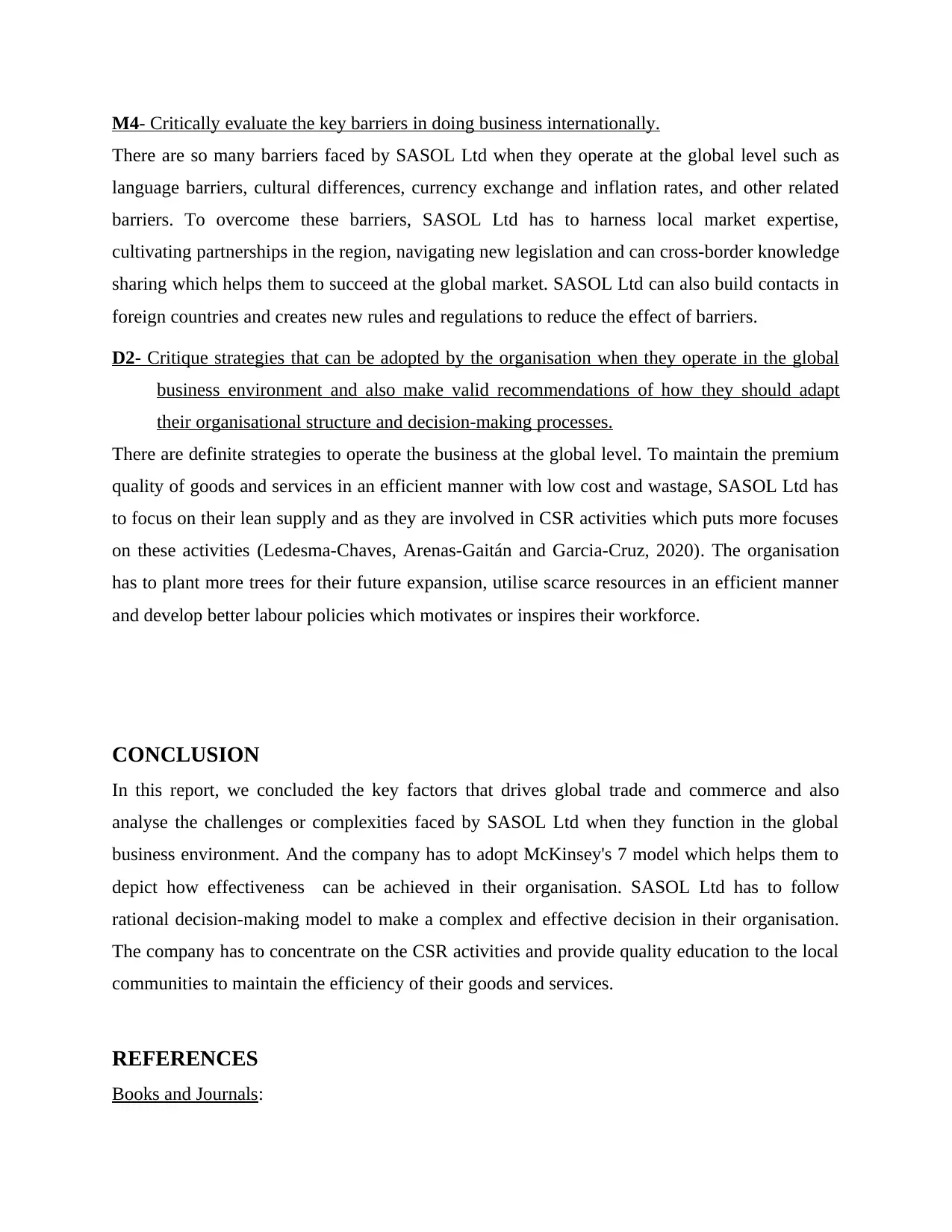
M4- Critically evaluate the key barriers in doing business internationally.
There are so many barriers faced by SASOL Ltd when they operate at the global level such as
language barriers, cultural differences, currency exchange and inflation rates, and other related
barriers. To overcome these barriers, SASOL Ltd has to harness local market expertise,
cultivating partnerships in the region, navigating new legislation and can cross-border knowledge
sharing which helps them to succeed at the global market. SASOL Ltd can also build contacts in
foreign countries and creates new rules and regulations to reduce the effect of barriers.
D2- Critique strategies that can be adopted by the organisation when they operate in the global
business environment and also make valid recommendations of how they should adapt
their organisational structure and decision-making processes.
There are definite strategies to operate the business at the global level. To maintain the premium
quality of goods and services in an efficient manner with low cost and wastage, SASOL Ltd has
to focus on their lean supply and as they are involved in CSR activities which puts more focuses
on these activities (Ledesma-Chaves, Arenas-Gaitán and Garcia-Cruz, 2020). The organisation
has to plant more trees for their future expansion, utilise scarce resources in an efficient manner
and develop better labour policies which motivates or inspires their workforce.
CONCLUSION
In this report, we concluded the key factors that drives global trade and commerce and also
analyse the challenges or complexities faced by SASOL Ltd when they function in the global
business environment. And the company has to adopt McKinsey's 7 model which helps them to
depict how effectiveness can be achieved in their organisation. SASOL Ltd has to follow
rational decision-making model to make a complex and effective decision in their organisation.
The company has to concentrate on the CSR activities and provide quality education to the local
communities to maintain the efficiency of their goods and services.
REFERENCES
Books and Journals:
There are so many barriers faced by SASOL Ltd when they operate at the global level such as
language barriers, cultural differences, currency exchange and inflation rates, and other related
barriers. To overcome these barriers, SASOL Ltd has to harness local market expertise,
cultivating partnerships in the region, navigating new legislation and can cross-border knowledge
sharing which helps them to succeed at the global market. SASOL Ltd can also build contacts in
foreign countries and creates new rules and regulations to reduce the effect of barriers.
D2- Critique strategies that can be adopted by the organisation when they operate in the global
business environment and also make valid recommendations of how they should adapt
their organisational structure and decision-making processes.
There are definite strategies to operate the business at the global level. To maintain the premium
quality of goods and services in an efficient manner with low cost and wastage, SASOL Ltd has
to focus on their lean supply and as they are involved in CSR activities which puts more focuses
on these activities (Ledesma-Chaves, Arenas-Gaitán and Garcia-Cruz, 2020). The organisation
has to plant more trees for their future expansion, utilise scarce resources in an efficient manner
and develop better labour policies which motivates or inspires their workforce.
CONCLUSION
In this report, we concluded the key factors that drives global trade and commerce and also
analyse the challenges or complexities faced by SASOL Ltd when they function in the global
business environment. And the company has to adopt McKinsey's 7 model which helps them to
depict how effectiveness can be achieved in their organisation. SASOL Ltd has to follow
rational decision-making model to make a complex and effective decision in their organisation.
The company has to concentrate on the CSR activities and provide quality education to the local
communities to maintain the efficiency of their goods and services.
REFERENCES
Books and Journals:
⊘ This is a preview!⊘
Do you want full access?
Subscribe today to unlock all pages.

Trusted by 1+ million students worldwide
1 out of 13
Related Documents
Your All-in-One AI-Powered Toolkit for Academic Success.
+13062052269
info@desklib.com
Available 24*7 on WhatsApp / Email
![[object Object]](/_next/static/media/star-bottom.7253800d.svg)
Unlock your academic potential
Copyright © 2020–2025 A2Z Services. All Rights Reserved. Developed and managed by ZUCOL.


